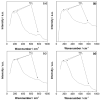A Tribological and Ion Released Research of Ti-Materials for Medical Devices
- PMID: 35009273
- PMCID: PMC8746336
- DOI: 10.3390/ma15010131
A Tribological and Ion Released Research of Ti-Materials for Medical Devices
Abstract
The increase in longevity worldwide has intensified the use of different types of prostheses for the human body, such as those used in dental work as well as in hip and knee replacements. Currently, Ti-6Al-4V is widely used as a joint implant due to its good mechanical properties and durability. However, studies have revealed that this alloy can release metal ions or particles harmful to human health. The mechanisms are not well understood yet and may involve wear and/or corrosion. Therefore, in this work, commercial pure titanium and a Ti-6Al-4V alloy were investigated before and after being exposed to a simulated biological fluid through tribological tests, surface analysis, and ionic dissolution characterization by ICP-AES. Before exposure, X-ray diffraction and optical microscopy revealed equiaxed α-Ti in both materials and β-Ti in Ti-6Al-4V. Scratch tests exhibited a lower coefficient of friction for Ti-6Al-4V alloy than commercially pure titanium. After exposure, X-ray photoelectron spectroscopy and surface-enhanced Raman spectroscopy results showed an oxide film formed by TiO2, both in commercially pure titanium and in Ti-6Al-4V, and by TiO and Al2O3 associated with the presence of the alloys. Furthermore, inductively coupled plasma atomic emission spectroscopy revealed that aluminum was the main ion released for Ti-6Al-4V, giving negligible values for the other metal ions.
Keywords: Ti-6Al-4V; ion release; scratch test; surface characterization.
Conflict of interest statement
The authors declare no conflict of interest. The funders had no role in the design of the study; in the collection, analyses, or interpretation of data; in the writing of the manuscript, or in the decision to publish the results.
Figures










References
-
- Ke Z., Yi C., Zhang L., He Z., Tan J., Jiang Y. Characterization of a new Ti-13Nb-13Zr-10Cu alloy with enhanced antibacterial activity for biomedical applications. Mater. Lett. 2019;253:335–338. doi: 10.1016/j.matlet.2019.07.008. - DOI
-
- Chen Q., Thouas G.A. Metallic implant biomaterials. Mater. Sci. Eng. R Rep. 2015;87:1–57. doi: 10.1016/j.mser.2014.10.001. - DOI
-
- Toptan F., Alves A.C., Carvalho Ó., Bartolomeu F., Pinto A.M.P., Silva F., Miranda G. Corrosion and tribocorrosion behaviour of Ti6Al4V produced by selective laser melting and hot pressing in comparison with the commercial alloy. J. Mater. Process. Technol. 2019;266:239–245. doi: 10.1016/j.jmatprotec.2018.11.008. - DOI
-
- Chávez J., Jimenez O., Olmos L., Farias I., Flores-Jimenez M., Suárez-Martínez R., Cabezas-Villa J.L., Lemus-Ruiz J. Tribocorrosion behavior of Ti64-xTa alloys fabricated through powder metallurgy. Mater. Lett. 2020:128590. doi: 10.1016/j.matlet.2020.128590. - DOI
Grants and funding
- 116060415/Comisión Nacional de Investigación Científica y Tecnológica
- 1180843/Comisión Nacional de Investigación Científica y Tecnológica
- 170087/Comisión Nacional de Investigación Científica y Tecnológica
- 170033/Comisión Nacional de Investigación Científica y Tecnológica
- Programa de Incentivo a la Iniciación Científica/Universidad técnica Federico Santa María
LinkOut - more resources
Full Text Sources

